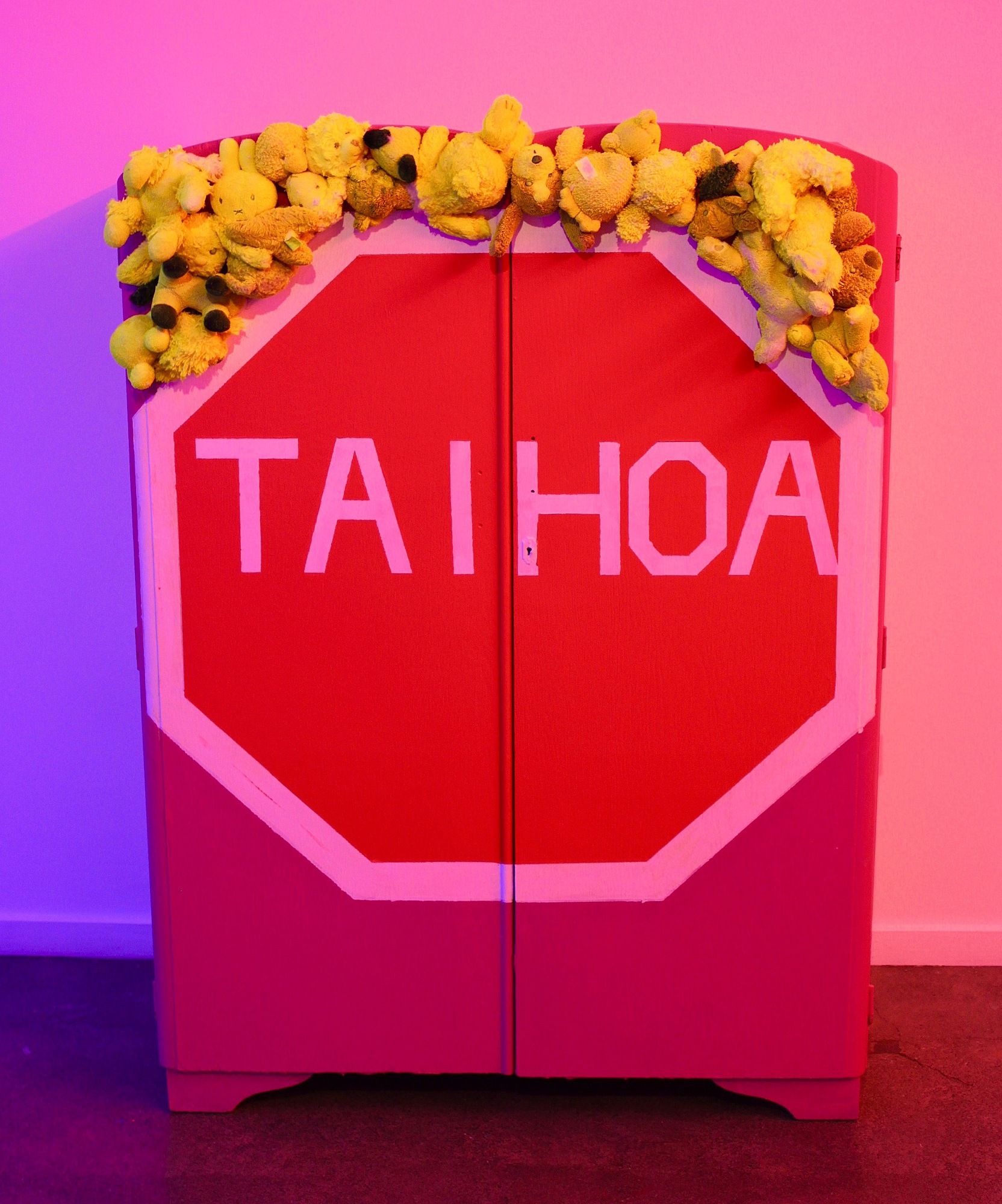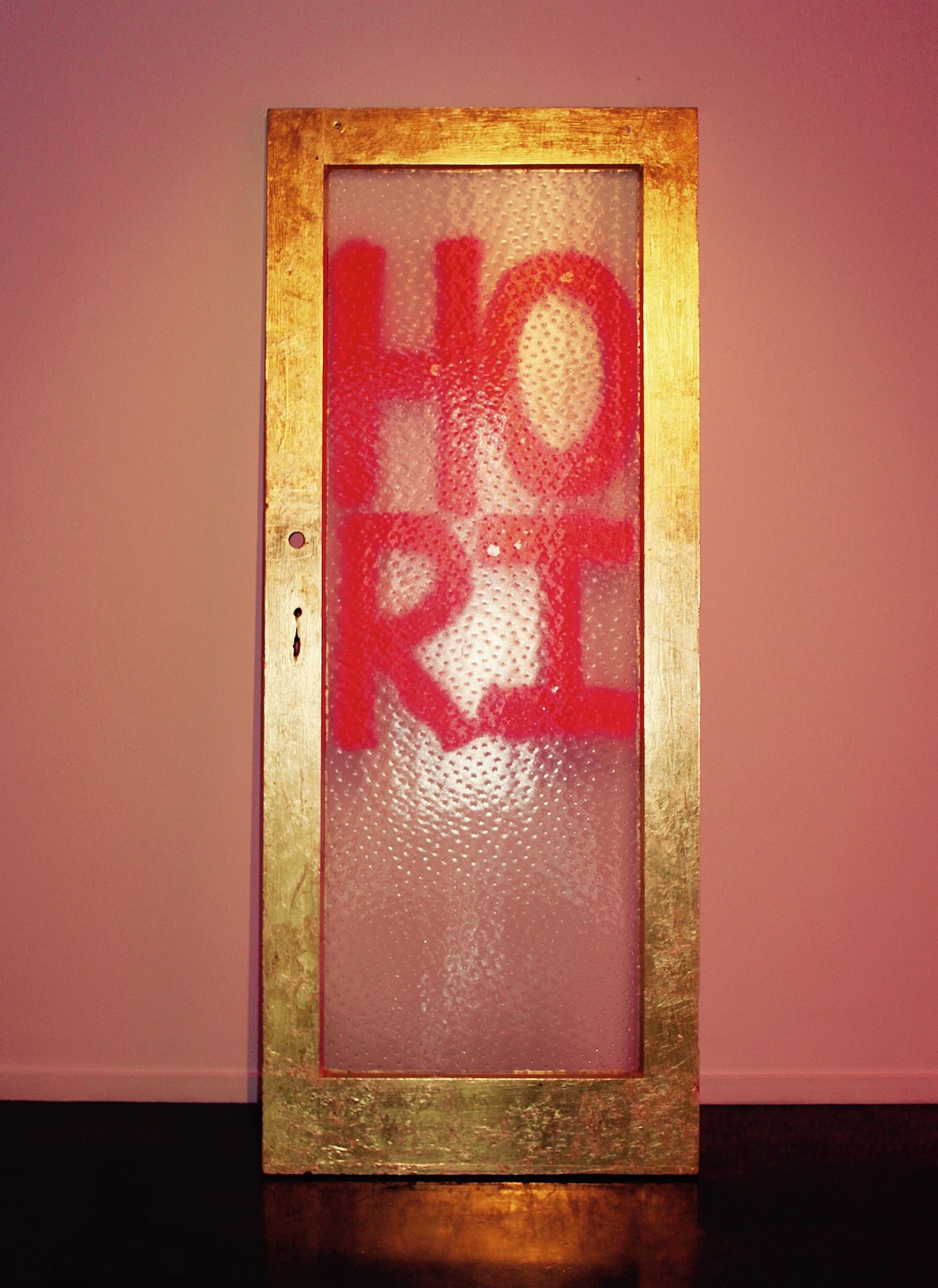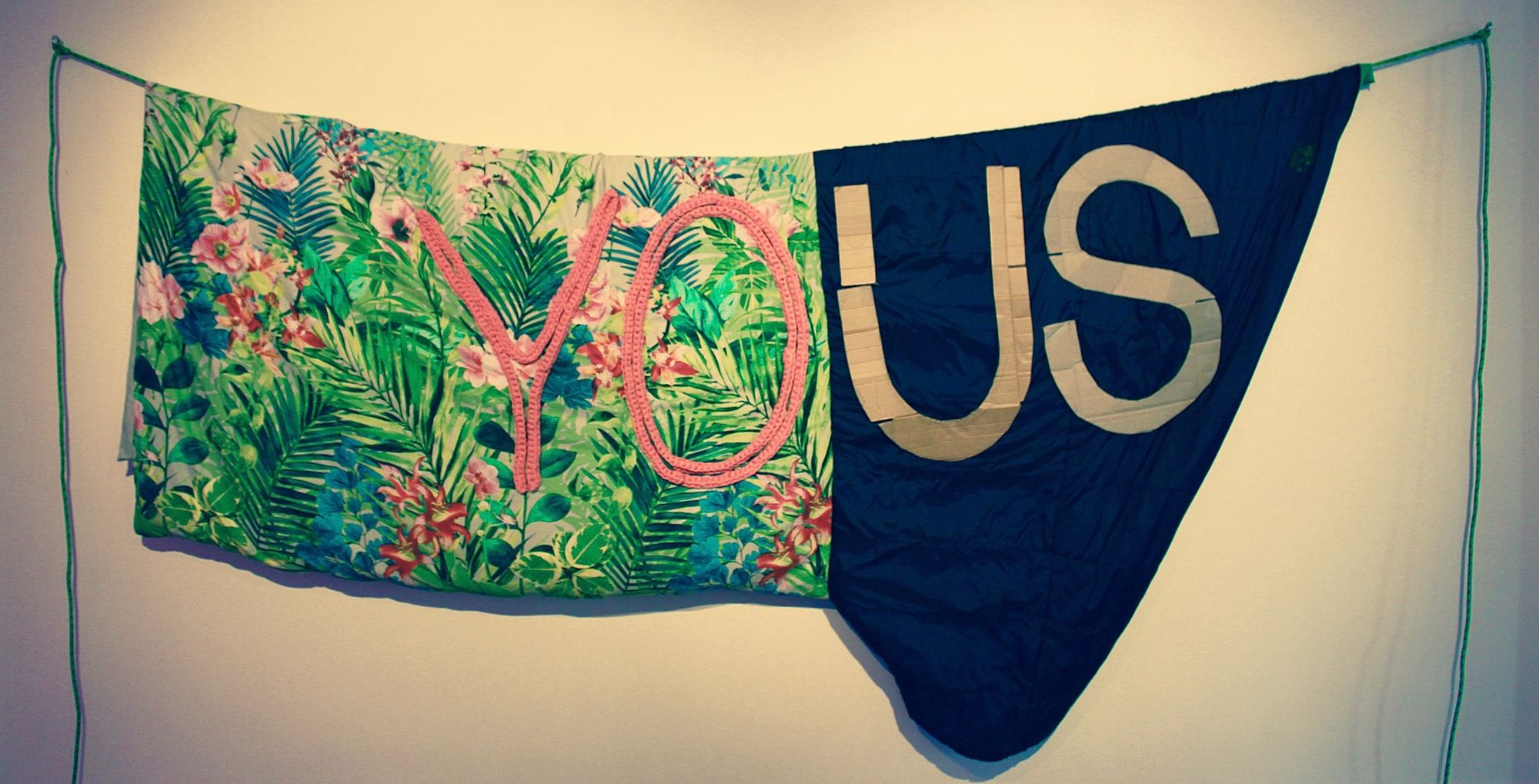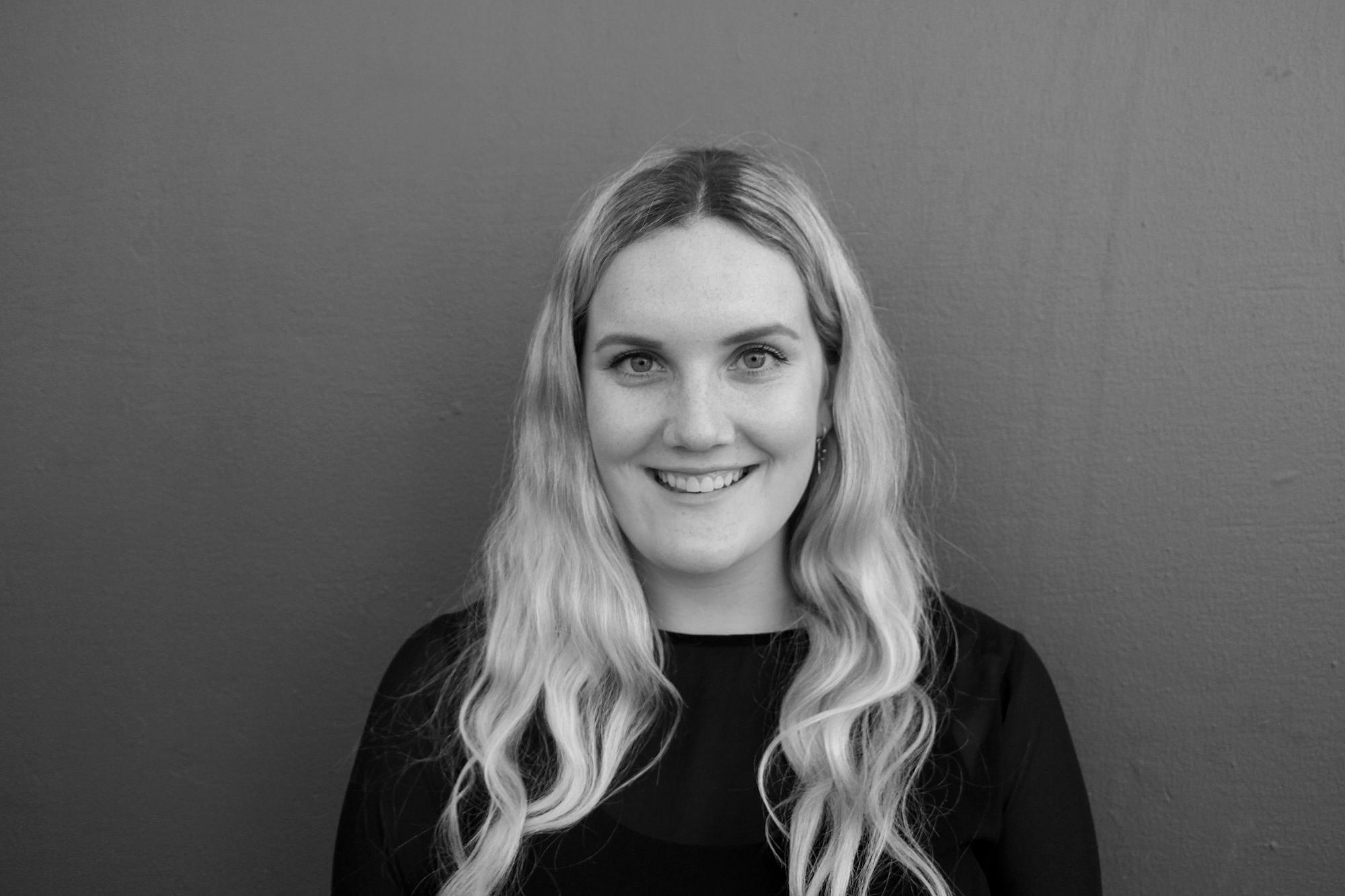Feeling Uncomfortable: An Interview with Gina Matchitt
Lucy Jackson and Gina Matchitt talk homelessness, te reo, kitsch and hope.
Lucy Jackson and Gina Matchitt talk homelessness, te reo, kitsch and hope.
Tackling the hard issues of today, Are Yous Okay? is an exhibition that makes me feel inherently uncomfortable, but for a good reason. Gina Matchitt (Te Arawa, Te Whakatohea) fills the gallery of Toi Pōneke with neon lights, broken glass, painted soft toys, fairy lights, and a pile of white plastic chairs. Each artwork features a kupu (word), either te reo Māori or slang, which is crocheted, painted, spray painted, sequined, or arranged in broken glass onto a mattress, a wardrobe, a blanket.
Matchitt’s practice fuses Māori and Pākehā concepts, exploring the traditions of Te Ao Māori, and adapting customary Māori patterns to contemporary materials. In Matchitt’s previous work she fuses recycled materials with Māori souvenirs, resulting in something which she describes as “Māori taste”. Confessing that the tourist “kitsch” elements in her work are influenced from her upbringing in Rotorua or Rota Vegas.
Matchitt’s use of everyday objects in Are Yous Okay? gives viewers a way into the work. We recognise the familial mink blanket from the Warehouse and the plastic chairs from parties. Depicting both Aotearoa’s problems with homelessness and child poverty, Are Yous Okay?, is tackling many issues, one of which would be enough to fill a whole gallery in itself. Matchitt blends te reo Māori with domestic, familiar objects to produce artworks that make us not only consider our own connection to these issues but also our relationship to te reo Māori.
Are Yous Okay? may make us feel uncomfortable. Both physically, under the neon lights of the gallery, and emotionally when forced to consider issues of homelessness and child poverty. Just as you feel the weight of these issues, Matchitt gives us a glimpse of hope. Chur is a patterned mink blanket with a pink crocheted kupu refering to the korowai worn for celebratory occasions such as graduation. Matchitt hopes that we will increase our vocabulary of te reo, recognise the problems and advocate for those who go without. After all, the Christmas tree lights of Awhi fill us with hope, indicating a time of year when many of us can relax and enjoy, but for others life goes on, without sparkling lights.
The gallery space, a Western construct, has disadvantaged and continues to disadvantage non-Western histories and artists. So the confrontation of not knowing te reo Māori, or realising the state of homelessness and poverty in Aotearoa can make us uncomfortable. However, this reality is crucial in forcing us to examine our own comfortability, or uncomfortability with the current privileging of some but not others.
Lucy Jackson: What was the inspiration or influence behind your new exhibition, Are Yous Okay?
Gina Matchitt: My family and I had been living overseas for seven years, and whilst I had always had Māori concepts and ideas in my work, when we came back three years ago, I felt like New Zealand had really regressed. Obviously, we’ve just had the election and hopefully the new coalition government will tackle the major issues, but I just really felt the difficulty of circumstances here. Homelessness is a major issue, we have the highest child poverty rate in the OECD and in these statistics Māori feature as the worst. I was really frustrated. On a personal level, we found it difficult coming back to such a high cost of living. I thought it would be okay, I would study and be able to get full time work but that hasn’t happened. I’m not saying I’m at the level [of poverty] I’m talking about in my work, but life has become really difficult for low and middle-income earners generally, and even worse for Māori.
That was where my concept came from, and then I worked on how to articulate that visually, through domestic materials.
LJ: Where were you living overseas, before you came back to Wellington?
GM: We lived in Washington DC for five years, and in Rome for two years. In DC there is an incredible high homeless population. One of my friends was actually a legal advocate for the homeless in DC. In the States there is very little welfare benefits, it’s basically non-existent. People rely on really low wages and a lot of people she worked with were working three jobs but still could not afford the rent in DC. America is meant to be the land of the free with equal opportunity for all but it is far from it, particularly for African American and Latino populations. It was interesting experiencing that, and then coming back to New Zealand where from the outside we are seen as such a paradise, who have made great strides towards equality, but realising that no we haven’t.
LJ: In Are Yous Okay? are you being political?
GM: Well, commenting on a Māori situation always seems to be labelled as political, which is interesting. During a RNZ interview, they said I was a political artist, which I didn’t propose. It is really interesting having that projected onto you. I suppose it is quite political, my sister would say I’m very political. If you are talking about these issues, highlighting them, or thinking about ways to solve them, then it can be seen as political.
LJ: In your previous work, you explore traditions of Te Ao Māori by reworking Māori patterns with contemporary materials. Do you explore this in Are Yous Okay? Or are you moving in a different direction?
GM: Usually, I bring a thread of something from my last exhibition into the new work. My last series was working on woven photographs, but I’ve put that to one side. I don’t have a woven pattern in Are Yous Okay? but I do have te reo Māori kupu which I have used in previous work, whether it’s a transliteration or a translation. There’s a push for te reo to be compulsory in schools, which I think is a great idea.
LJ: So, in the exhibition, the te reo is not explained?
GM: No. I think it’s about getting people to actually think, and look up definitions of the words. I don’t give the definition, or say whether it’s slang or Māori. I think it’s good for people to have to research if they want to find out more, if they don’t know the meanings.
LJ: Language can be misconstrued, are you actively re-contextualising te reo?
GM: No. In Māori, words can have many meanings depending on their context or how the sentence is structured. I’m not a speaker of Māori, so I’m not an expert at all, but I know that hoha for example, has multiple meanings. It can mean that you are hoha but you can also feel hoha. It can be used to mean anything from feeling annoyed, a nuisance, or that you can’t be bothered. In The Uncomfortable Bed, I was mixing these meanings of the word. It can be about how hoha I am about politicians, or the how the system of government was hoha, not doing anything about these issues. That’s my interpretation, viewers, will have their own.
LJ: Are people who might not know the meaning of the words, such as Pākehā, disadvantaged?
GM: Maybe, but then you have to research them to find out. It would be interesting if they felt disadvantaged, because I feel like Māori have been disadvantaged for years. I think there are really good resources online, for example, the Māori dictionary, where there are examples of use the words in a sentence. But if Pākehā do feel disadvantaged then they need to be pushed out of their comfort zone.
LJ: Totally. And being taken outside of your comfort zone is a good thing.
GM: That is an issue too for some Pākehā, maybe not the younger generation, but for older Pākehā New Zealanders, any shift away from English or things they do not understand (in terms of language or culture) makes them uncomfortable. I’m sorry, but you have to suck it up and accept that this language is indigenous and there needs to be a change.
My Mother grew up in Ruatoki, and went to a native school and was punished for speaking Māori at school. So that is what has happened throughout a generation, and my parents did not teach us Māori because of that. My mother said she didn’t teach us because she thought you needed both parents to learn it and Dad wasn’t a speaker. But when you look at Europe and see people are bilingual or trilingual, you realise that doesn’t actually matter. But, culturally, in the 1960s and 1970s that wasn’t what you did. They even wanted to give me a Māori name, but an old Auntie of Dad’s said no, they shouldn’t do that.
There are many things like this that I have come to realise in later life made an impact. I feel like my generation in particular are the ones that have missed out, because the younger ones are growing up and going to kura, so have more opportunity to learn te reo Māori.
LJ: How did you feel growing up, when you heard, or didn’t hear, te reo being used?
GM: It was interesting because my mother would meet people in the street from out of town and would have a conversation in Māori. I was used to going to marae from a really young age, but it almost seemed like Māori was the language spoken on the marae or with these people, I didn’t see it as being filtered into everyday life.
LJ: You felt things had got worse with homelessness and poverty in New Zealand, but do you think that te reo Māori has made progress? It’s nowhere near perfect but do you think these things have crossed over?
GM: Yeah, definitely. There’s always people working, making strides and promoting te reo. Before we went overseas I worked for a wananga, Te Whare Wānanga o Awanuiārangi in Whakatane. So I knew that wananga Māori kaupapa institutions were making a difference. It was interesting too, that in that framework, teaching Māori adults who had kind of failed in the Pākehā system, and then coming into the Māori system and succeeding.
While I was away, I felt like things were progressing, but when I came back I just thought about how some people can’t get out of poverty or that cycle of low paid wages. Education and upskilling in some form, not necessarily in tertiary institutions, is a way to break that cycle. I also think the Treaty settlements are really contributing to iwi becoming more self-sufficient and developing an economic base. Many iwi are also building cultural centres and that all helps to build resilience and pride.
LJ: Do you intend for your work to be seen as kitsch?
GM: Totally. I can’t escape it. Again, I refer back to growing up in Rotorua and that weird Rota Vegas, touristy thing. Those sort of 60s and 70s kitsch Māori souvenirs have influenced my work a lot. I mean I love it, I love the glitter, the purple houses, the wild colours. I call it Māori taste. I used to have this real love-hate relationship with Rotorua. When I was a teenager, I wanted to get out of there as soon as possible, but I have come to really appreciate its influence. I like the kitschiness, the sparkle.
It also works on another level, I see my work as making something look pretty, frivolous or colourful, but underneath it has a deeper meaning. I think that’s how my work best communicates. It takes contemporary culture or a Māori interpretation of contemporary culture and subverts it, but the underlying seriousness is still there.
LJ: In Are Yous Okay? is it up to the viewer to see underneath the glitter and neon lights?
GM: Yes and there is the potential to develop this further, to take the stronger pieces and make other works that develop the same idea but in a slightly different way, while still using the same types of materials.
LJ: And you’ve chosen to use domestic materials, like the blanket, mattress and chairs, is that from an idea that some people don’t have these?
GM: Yes and a reference to all the things that we take for granted; we have a bed to sleep on, we have something to sit on, we are warm. It is about that comfort and questioning our own comfort. It is funny because other things come out from the materials too. When I was talking to Paora Allen, the Director of Toi Pōneke, he mentioned the use of plastic chairs at parties in the garage. Another reason I chose them was that I have a small house and I wanted something I could stack. It’s practical, but has all those other connotations as well.
LJ: Plus, probably every New Zealander recognises them.
GM: Exactly. I do quite like taking those things people might throw out or overlook and making them into an artwork. Also, most of the materials I bought were from Wellington Op Shops, so they are recycled. I like the idea that if I buy these materials I’m giving to a charity and also being resourceful by reusing something. That’s something else I like about Māori culture, it’s about using what you’ve got, what’s around you, and making things work for you. Some of the items are new though, like the black and white blanket from the Warehouse.
LJ: I know, because I used to have one. I absolutely begged my parents for one when I was about 15. I recognised it in your show straight away.
GM: Really! I saw that blanket and thought straight away ‘that’s a patikitiki pattern’. I see the Māori in it.
LJ: It’s a New Zealand icon, the Warehouse mink blanket.
GM: Yes it is.
LJ: What type of response are you trying to elicit from viewers?
GM: Well, I suppose I want people to enjoy the kitschiness of it, but also think a little bit more. I want them to go away and learn a few more Māori words. I think that’s the main thing, to really have a reaction, to see The Uncomfortable Bed and feel uneasy, and think, ‘what is she doing here?, what is she talking about?, what does she want us to think about?’.
LJ: Do you want people to feel uncomfortable?
GM: Yes, because then I think it’s serving its purpose. It is mostly negative, questioning things, such as how the last government has contributed to these dire situations. But I also have a few positives in there, like Awhi, and Chur. I still want to have a little bit of hope and humour as well. I always do that, even if there is negativity, I also have elements of positivity. I feel like I have to balance it out.
LJ: Even if the subject matter is heavy, the way you’ve used kitsch, and neon lights, you can’t help feel a little hopeful. Fairy lights help too.
GM: Christmas lights are perfect - apart from they are difficult to shape. But then again they fit into my practice, they are that domestic, frivolous and sparkly familiar object again.





